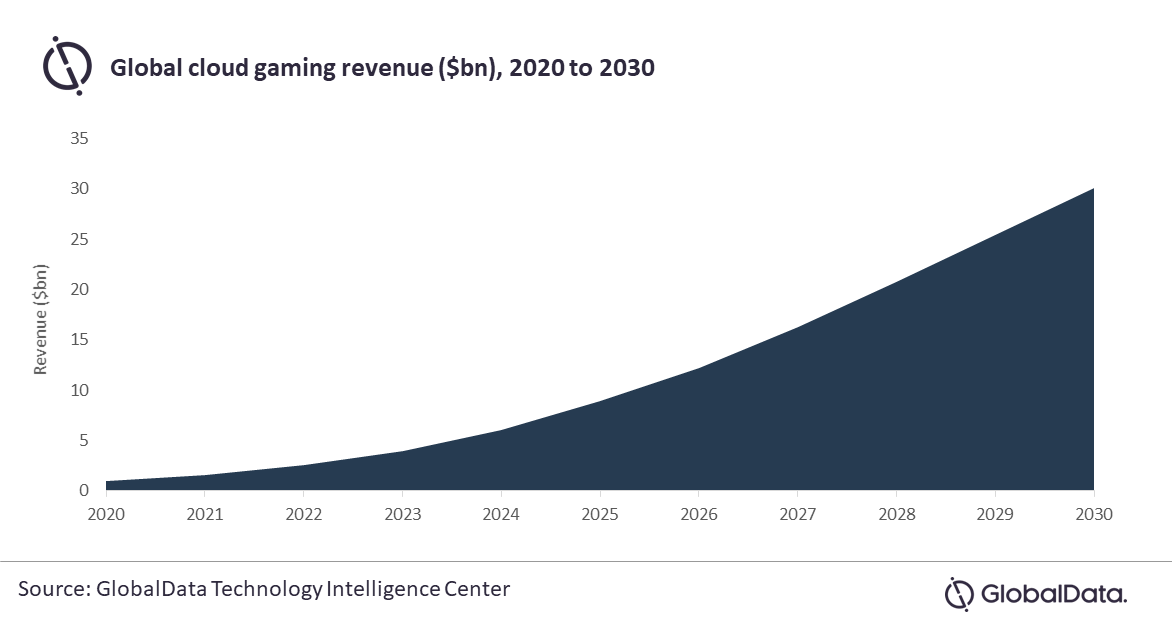< Key Hightlight >
Cloud gaming will fundamentally change the video games industry over the next ten years, bidding farewell to traditional disk-based PC and console games and hefty downloads in the process. Just as video and audio streaming has reshaped the music, film and TV markets, cloud gaming is expected to disrupt the status-quo in the gaming world. In fact, the cloud gaming market is expected to be worth $30bn in 2030, according to GlobalData forecasts – a massive rise from 2020’s $1bn and showing an impressive compound annual growth rate of 40% over the ten-year period.
Rupantar Guha, Associate Project Manager for Thematic Research at GlobalData, commented: “By revenue, cloud gaming accounted for less than 1% of the video games industry in 2020, but it has the potential to disrupt how games are distributed, consumed and monetized. There is no doubt that in ten years’ time, there will be no more new PC and console games on the shelves, replaced instead by games hosted in the cloud and accessed via thin-client PCs, consoles or mobiles.”
Our latest report notes that, while the cloud gaming market is currently at a very early stage of development, competition is intensifying, drawing in tech giants (including Sony, Google, Tencent, Microsoft, Nvidia, Facebook, and Amazon) and telcos (like Deutsche Telekom, Verizon, AT&T, Vodafone, KT, and China Mobile). Game publishers, including Ubisoft and Electronic Arts, have also formed partnerships with service providers to increase their prominence in this developing market.

Guha continued: “One major issue for the technology is the need for users to have fast internet connections beyond existing 4G networks’ capabilities. The slow deployment of 5G networks will restrict its growth for at least the next two years. Therefore, cloud gaming providers and telcos will experiment with 5G in specific geographical locations to improve service quality and experience until 5G becomes widespread.”
Scope
This report provides an overview of the cloud gaming theme.
- It identifies the key trends impacting growth of the theme over the next 12 to 24 months, split into three categories: technology trends, macroeconomic trends, and regulatory trends.
- It includes a comprehensive industry analysis, including forecasts for cloud gaming revenues to 2030.
- The detailed value chain comprises four layers: a content layer, a service layer, a connectivity layer, and a device layer.
Key Highlights
Tech giants like Google, Microsoft, Sony, and Nvidia are banking on subscription models to help them become the “Netflix of gaming”. Exclusive content will be critical to attracting customers. Thanks to their massive libraries of exclusive games, Microsoft, Sony, and Tencent are potential winners in the subscription model. Providers of subscription-based cloud gaming services that lack exclusive games will struggle to compete.
Reasons to buy
Worth $1bn in 2020, the global cloud gaming market will grow to become a $30bn industry by 2030, at a compound annual growth rate (CAGR) of 40% over this 10-year period, according to GlobalData estimates.
By revenue, cloud gaming accounted for less than 1% of the video games industry in 2020, but it has the potential to disrupt how games are distributed, consumed, and monetized. In 10 years, traditional PC and console games will have been replaced by games hosted in the cloud and accessed via thin-client PCs, consoles, or mobiles.
Companies mentioned
Activision Blizzard
Akamai
Alibaba
Alphabet
Amazon
Apple
Asus
AT&T
Bandai Namco
BBK Electronics
Boyaa
BT Group
Capcom
China Mobile
Colopl
Corsair
Dell
DeNA
Deutsche Telecom
Electronic Arts
Epic Games
F5 Networks
Facebook
Gamevil
Glu Mobile
GungHo Online
HP
Huawei
IBM
IGG
Kingsoft
Konami
KT
Lenovo
Microsoft
NCSoft
NetEase
Netmarble
Nexon
Nintendo
Nvidia
Perfect World
Playtech
Razer
Samsung Electronics
Sea
Sega Sammy
SK Telecom
Sony
Square Enix
Take-Two Interactive
Tencent
Ubisoft
Unity Technologies
Valve Corp
Verizon
Vivendi
Webzen
Xiaomi
Zynga




